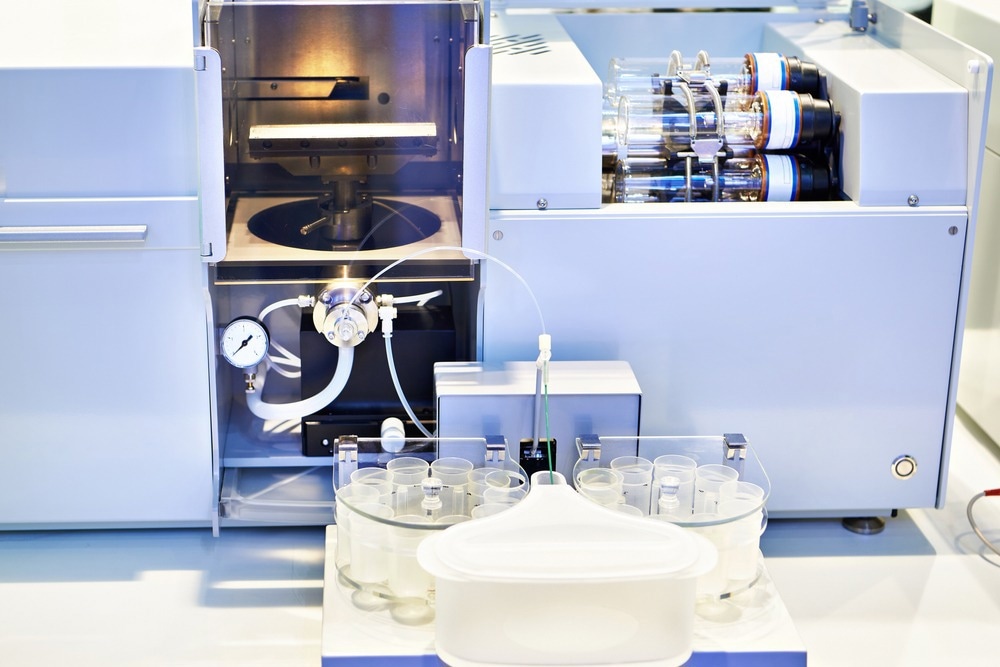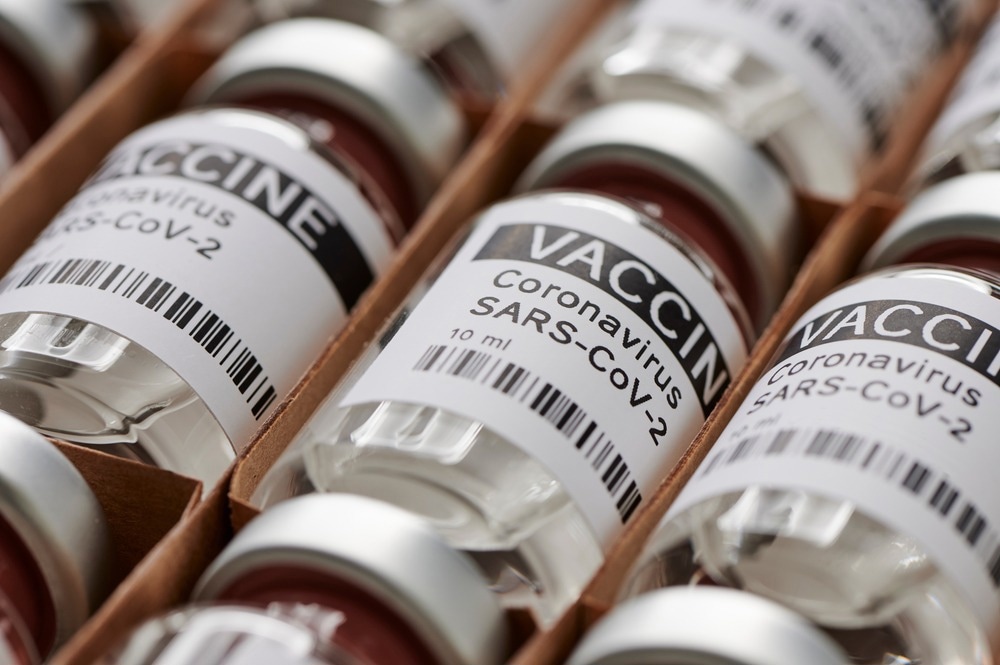Spectrometry technology has been around for many decades; however, its status has recently been elevated due to its use by researchers at the University of Surrey in COVID-19 vaccine development.
In recent years, the technique has become fundamental to emerging fields of science, such as proteomics and metabolomics, as well as to long-standing sectors, including forensic and pharmaceutical analysis. New research is being published demonstrating the growing importance of spectrometry, which is helping to fuel the global market growth, which North America currently dominates.

Image Credit: Sergey Ryzhov/Shutterstock.com
Application Areas of Spectrometry
Spectrometry is a vitally important tool for analyzing molecular structures. It is one of the most widely used techniques to gain information on the molecular weight of a sample, as it can provide incredibly accurate data. The mass spectrometer was first developed in 1912 by J.J. Thomson after discovering the electron in 1897. Thomson used his spectrometer to produce the first evidence of nonradioactive isotopes. Since then, spectrometry has been fundamental to numerous scientific advances and has become established in a wide range of applications.
Specific applications of spectrometry include drug testing and discovery, medical research (proteomics, metabolomics, forensic analysis, and pharmaceutical analysis), quality control (food), pesticide residue analysis, protein identification, isotope ratio determination, carbon dating, the study of spectral emission lines of distant galaxies, analyzing freshwater and marine ecosystems, analyzing respiratory gas in hospitals.
Hot Topics in Spectrometry
Recently, numerous publications have reported using spectrometry techniques in novel ways to deepen our understanding of various fields of science. Nanoscience, in particular, has benefitted from recent applications of spectrometry.
In 2022, scientists at Drexel University reported a new secondary-ion mass spectrometry technique that they used to provide a novel look at two-dimensional layered materials (MXenes and MAX phases). The technology gives a new understanding of the complex structure and chemical composition of the materials, vital to establishing new applications of the promising materials.
Also, in 2022, scientists at the American Institute of Physics published findings of their innovation that used a novel on-chip spectrometer to understand various aspects of light, such as angle and spectrum, that other methods had failed to analyze accurately. The platform will be used to improve image sensors for machine vision.
There have also been significant developments in our understanding of biological systems at the cellular level. Recently, researchers at Tokyo Medical and Dental University used mass spectrometry to visualize membrane lipids at an unprecedented level. The novel methodology enhances research into phosphoinositides, which has implications for the treatment of a number of diseases.
Finally, spectrometry research is also advancing the field of virology. Scientists at the University of Birmingham recently published their research in the journal PLOS Pathogens, illustrating their use of mass spectrometry-based prototyping combined with super-resolution microscopy to reveal the proteins implicated in poxvirus infections. The team's research has uncovered how these proteins interfere with the innate immune system, opening the door to developing anti-poxvirus treatments.
In recent years, teams involved in virology research have become strong adopters of spectrometry technology. Agilent Technologies, Inc., for example, is frequently involved in research and development for vaccines. The company worked on developing COVID-19 vaccines, which attracted much attention to the application of spectrometry in this field.

Image Credit: M-Foto/Shutterstock.com
Current Global Market of Spectrometry
The global spectrometry market was valued at $14.1 billion in 2020 and is predicted to grow at a CAGR of 7.2% from 2021 to 2028. North America currently dominates the market, holding 46.7% of the revenue share in 2020. However, Asia Pacific looks positioned to potentially emerge as the strongest region in the coming years.
Currently, the region is home to a strong research base for drug development which will enhance the adoption of spectrometry technology in the Asia Pacific in the near future. Countries such as China, Japan, and India have made significant contributions to the market's growth in Asia Pacific which may overtake the US by the end of the decade.
The market is fueled by the development of advanced spectroscopy instruments and consumables, which are helping to further medical and pharmaceutical research.
Molecular spectrometry, in particular, dominated the market and accounted for 37.6% of the revenue share in 2020. This is mainly due to the wide adoption of molecular spectrometry across the life science sectors and the commercial availability of the technology. PerkinElmer, Inc., for example, provides a wide range of instruments, software, consumables, and informatics in molecular spectroscopy.
Overall, the instrument segment dominated the market in 2020, accounting for 71.2% of the revenue share. The success of this segment is attributed to the increasing adoption of spectrometry methods in biotechnology.
Main players in the industry include Thermo Fisher Scientific, Inc., PerkinElmer, Inc., Agilent Technologies, Waters Corporation, Shimadzu Corporation, Bruker Corporation, JEOL Ltd., FLIR Systems, Inc., Endress+Hauser Group and MKS Instruments, Inc., among others.
Future Directions for Spectrometry
Several key factors, including technological advancements in spectrometry, the increased global spending on research and design by the pharmaceutical industry, and the increased focus on research and design by government research organizations, will drive future directions for the global spectrometry market.
The establishment of novel, advanced spectrometry technology is also expected in the near future. This will open up new avenues for spectrometry applications, which we will likely see develop throughout the decade. Recent studies have indicated how spectrometry techniques can be useful for proteomics and metabolomics research. This means that spectrometry may become invaluable in helping develop new diagnostic, prognostic, and therapeutic approaches to various diseases, including cancer.
Final Thoughts
Spectrometry has been around for many years; however, it seems it is yet to reach its full potential. The technique has the opportunity to further research and development into various diseases, which may lead to novel diagnostic, prognostic, and therapeutic approaches. The use of spectrometry by researchers working on COVID-19 vaccines helped highlight the importance of this method, which may help boost the market's growth over the next decade.
Sources:
- Bidgood, S., Samolej, J., Novy, K., Collopy, A., Albrecht, D., Krause, M., Burden, J., Wollscheid, B. and Mercer, J., 2022. Poxviruses package viral redox proteins in lateral bodies and modulate the host oxidative response. PLOS Pathogens, 18(7), p.e1010614. journals.plos.org/.../journal.ppat.1010614
- Michałowski, P., Anayee, M., Mathis, T., Kozdra, S., Wójcik, A., Hantanasirisakul, K., Jóźwik, I., Piątkowska, A., Możdżonek, M., Malinowska, A., Diduszko, R., Wierzbicka, E. and Gogotsi, Y., 2022. Oxycarbide MXenes and MAX phases identification using monoatomic layer-by-layer analysis with ultralow-energy secondary-ion mass spectrometry. Nature Nanotechnology,. https://www.nature.com/articles/s41565-022-01214-0
- Morioka, S., Nakanishi, H., Yamamoto, T., Hasegawa, J., Tokuda, E., Hikita, T., Sakihara, T., Kugii, Y., Oneyama, C., Yamazaki, M., Suzuki, A., Sasaki, J. and Sasaki, T., 2022. A mass spectrometric method for in-depth profiling of phosphoinositide regioisomers and their disease-associated regulation. Nature Communications, 13(1). https://www.nature.com/articles/s41467-021-27648-z
- Spectrometry Market Size, Share & Trends Analysis Report By Type, By Product, By Application (Pharmaceutical Analysis, Forensic Analysis, Proteomics, Metabolomics), By End-use, By Region, And Segment Forecasts, 2021 - 2028 [online]. Grand View Research. Available at: www.grandviewresearch.com/industry-analysis/spectrometry-market (Last accessed October 2022)
- Qu, Y., Yi, S., Yang, L. and Yu, Z., 2022. Multimodal light-sensing pixel arrays. Applied Physics Letters, 121(4), p.040501. https://aip.scitation.org/doi/10.1063/5.0090138
Further Reading
Last Updated: Dec 13, 2022